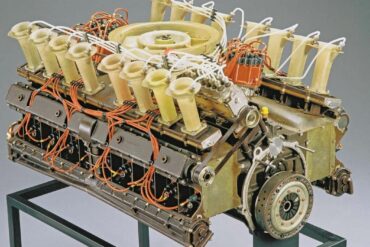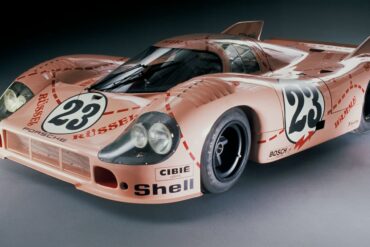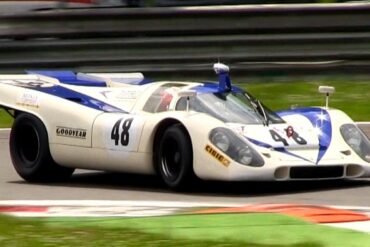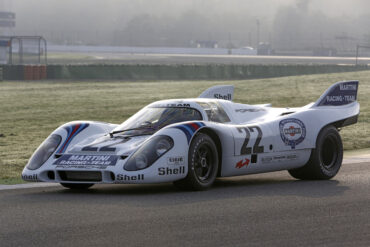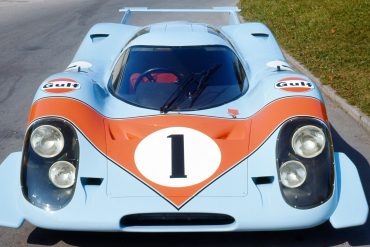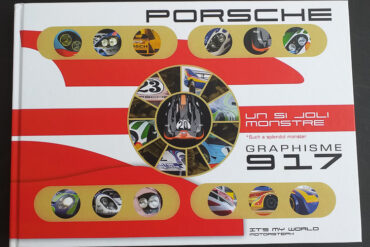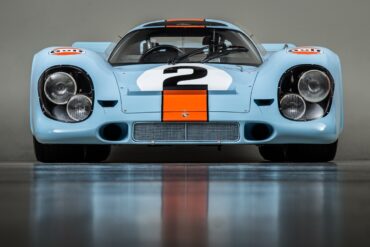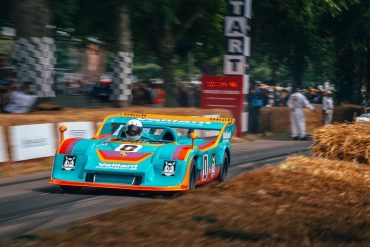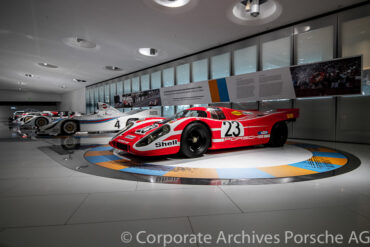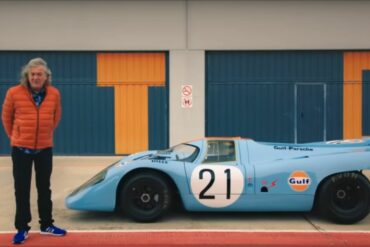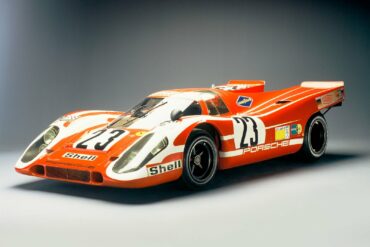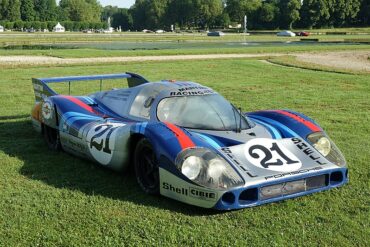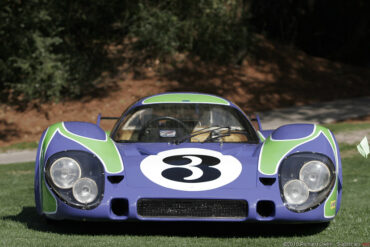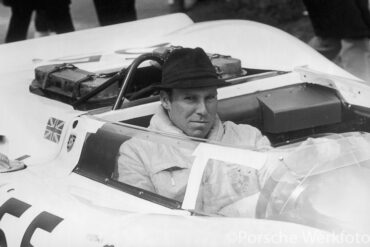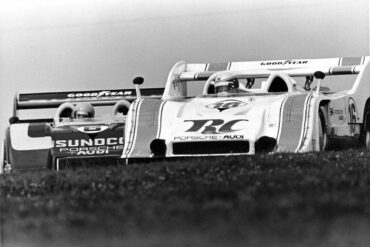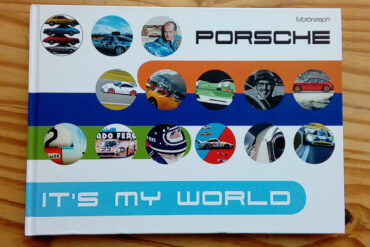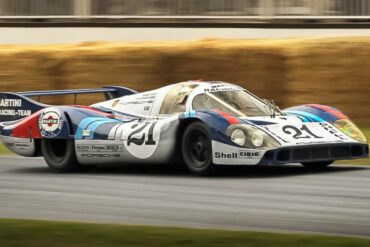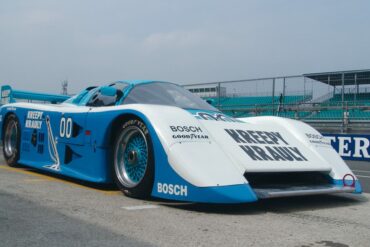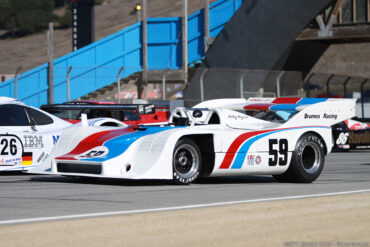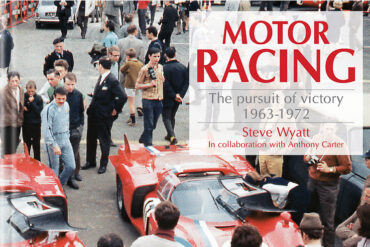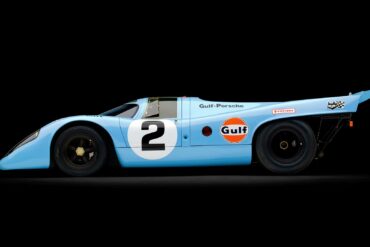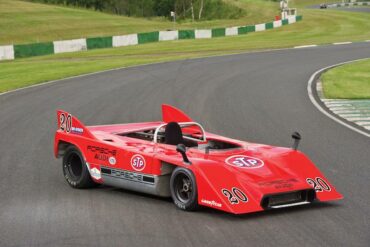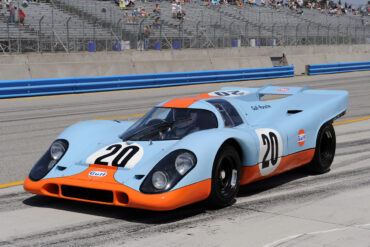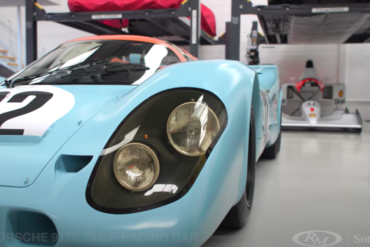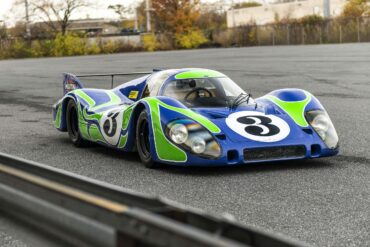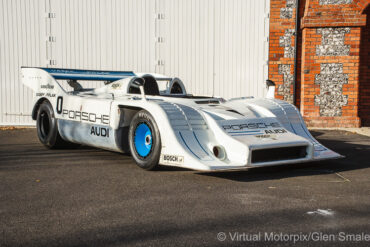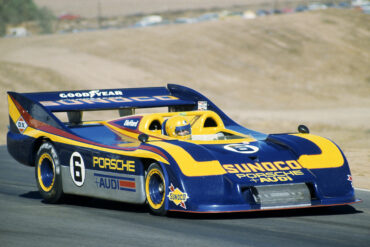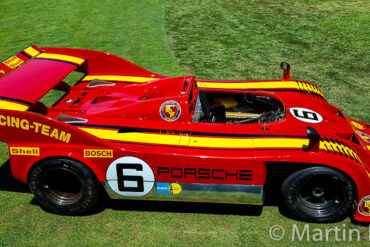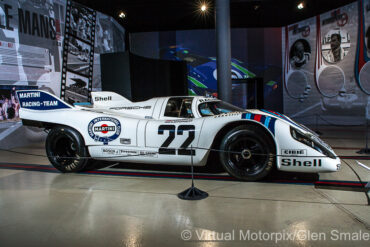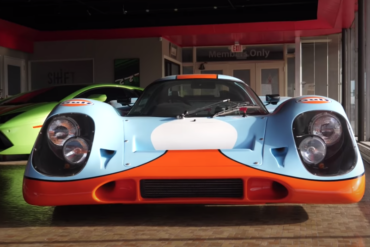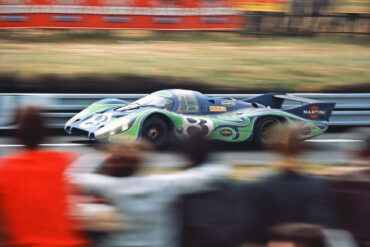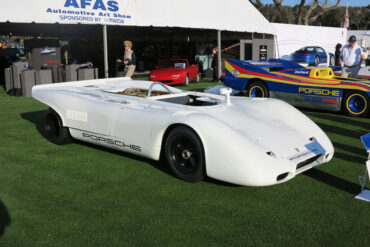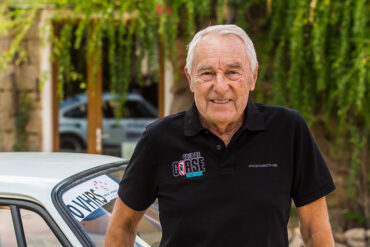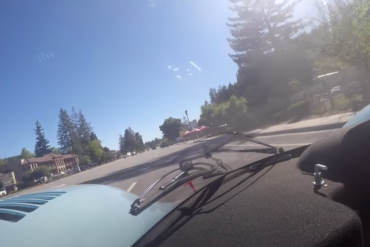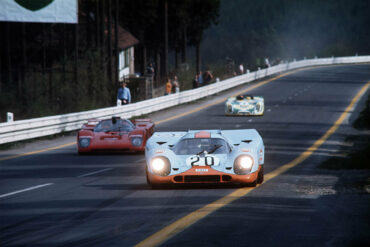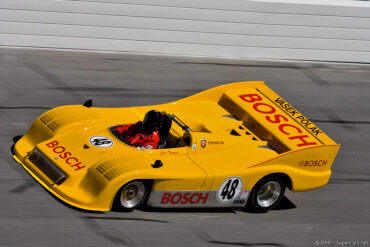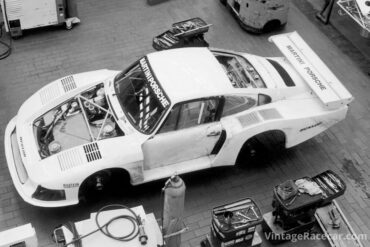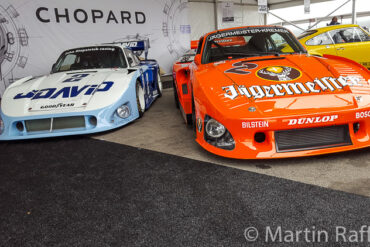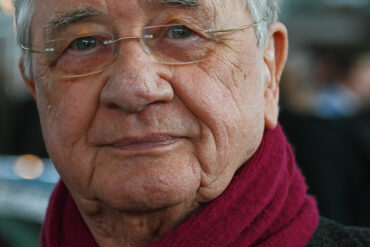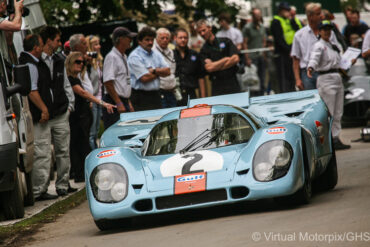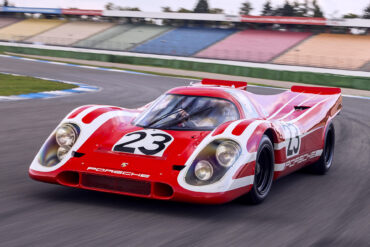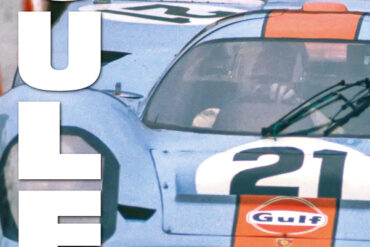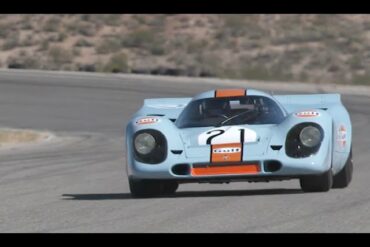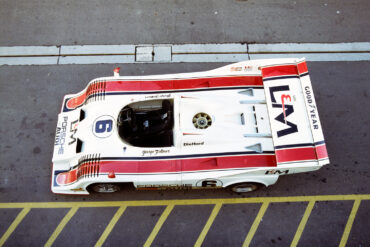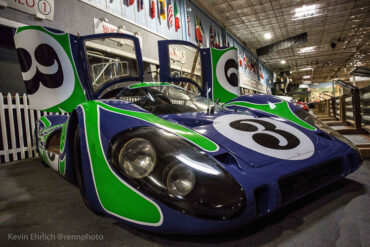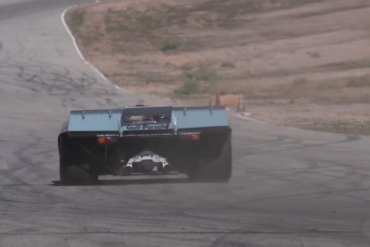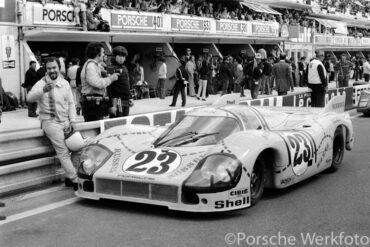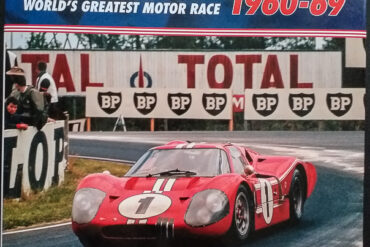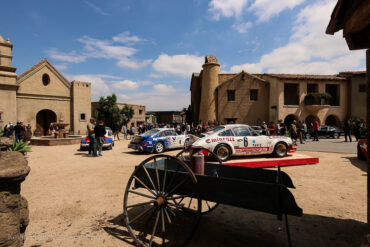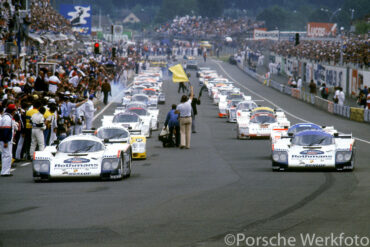1970 Porsche 917/10 prototype chassis #917/10-001 as offered for sale on 8 February 2017 Mention the name Porsche and motor...
The Porsche 917-001 will be shown in the Porsche Museum for the first time in its original condition My 2019...
The Engines Engine Type 912 – 12 Cylinders The Porsche House made it the norm since 1967 to participate in the tests for...
An attempt to blend the best aerodynamic characteristics from both the short-tailed 917 K and long-tailed 917 LH led to the the 917/20, otherwise known as the Pink Pig. The car's combination of a long body, stubby face, and wide hips gave it a pig-like look, which inspired Porsche designer Anatole Lapine to give the car a pink paint job with butcher cut lines covering the exterior. It was hugely popular at the 1971 Le Mans race, and was the fastest in qualifying and nearly came in fifth place, before a brake failure caused it to crash before the finish line.
Porsche 917 vs Porsche 911 GT2RS James May joins the legendary Dickie Atwood to race the Porsche 917 against Neel...
Have you seen a Porsche 917 in action outside of Le Mans? If not, you’re in for a treat as...
The Martini team run by Hans-Dieter Dechent had three cars, two to race, and one T-car. The #3 was driven by...
Enjoy a close-up experience of the history of Porsche at the Porsche Museum, at night when the museum comes alive!...
The “shark fins” on the tail gave the Porsche 917 KH 1971 greater directional stability and reduced wind resistance by 11 percent. In 1971 a veritable armada of six Porsche 917s started at Le Mans. The car with start number 22 was special. The white race car with the characteristic Martini stripes had the new “shark fins” on the tail that Porsche had first used in pretraining in April. This 917 was also the first Porsche with a magnesium tubular frame to be used in a race.
Held in the grounds of Hedingham Castle, Classics at the Castle is a very special Porsche car show held annually....
Watch as Bruce Canepa gets behind the wheel of a 1969 Porsche 917K with chassis number 917-015 around the famous...
50 years of the Porsche 917 Anniversary The most famous racing car of all time made its debut at the...
Porsche – Graphisme 917 by Stéphane Coradi © Virtual Motorpix/Glen Smale Porsche Graphisme 917: This is Stéphane Coradi’s second publication...
Although the longtail 917 was introduced first, it was meant only for the Le Mans. This meant, the short tail 917 K ("Kurz" in German for short) was raced first. The only engine available in 1969 was the 4.5-litre flat 12. The factory team enters one 917 K also for the Nürburgring 1000 km race, where it scores 8th. The factory team would not enter 917 K for racing anymore in the season, only private teams will.
Despite being 50 years old, the formidable Porsche 917/30 still boasts a power-to-weight ratio that rivals that of a modern...
The 1970 #23 Porsche 917 KH at the Le Mans 50 years victory celebration at the Museum on 13/14 June...
In our series of looking back at the racing icons of history this month, in preparation of global motorsports returning...
The Porsche 917 – What They Said We found some great interviews from back in the day on what drivers...
1971 Porsche 917 Langheck Pictures...
The loophole Porsche racecar Ferrari couldn’t touch! The Porsche 917 was the brainchild of engineering genius Ferdinand Piëch, the grandchild...
Le Mans: The Official History 1970–79 by Quentin Spurring © Virtual Motorpix/Glen Smale This edition of Quentin Spurring’s fabulous series...
Porsche 917 Turns 40 Porsche launched the 917 40 years ago and it’s still their most important racecar to date. This...
In 1996 the 30 years of the Canadian – American Challenge Cup series were celebrated, better known as CanAm and which only...
Motor racing has always involved risk for the drivers, and sometimes for spectators too, as was seen to horrific effect...
Peter Falk sits on the sill of the famous #23 Porsche 917 KH Coupé, winner of the 1970 Le Mans...
Renowned designer and Porsche aficionado Magnus Walker got the opportunity to get behind the wheel of a Porsche 917K replica...
Richard Attwood relaxing between stints in the Drivers’ Paddock during the 2013 Goodwood Festival of Speed On 4 April this...
The Can-Am Porsche 917 The Can-Am Race Series, held from 1966 to 1974, helped propel professional sports car racing to...
Works Porsche 956 – The Definitive History: by Serge Vanbockryck – © Porter Press International I met the author, Serge...
Porsche – It’s My World by Stéphane Coradi © Virtual Motorpix/Glen Smale Porsche – It’s My World: what is this...
1971 Porsche 917 Langheck Specifications 4.9 L Flat 12 Engine Spec type Racing Car built at Germany engine Air Cooled...
I couldn’t quite pinpoint why, during the research and writing of this profile, that I kept hearing the Lennon/McCartney hit...
Porsche – The Golden Years: Leonardo Acerbi © Virtual Motorpix/Glen Smale It is always a pleasure when a top-quality book...
1971 – 1972 Porsche 917/10 Pictures...
Drivers View Porsche 917K On Track A visor-cam in a $20 million Porsche 917K? Absolutely. Let driver Bruce Canepa and...
Gulf Porsche chassis 917-016 Under the welcoming embrace of sunny California skies over wine country, the Sonoma Speed Festival established...
Background The Porsche 917, unveiled in 1969, stands as a testament to Porsche’s commitment to innovation and their quest to...
Motor Racing – The Pursuit of Victory 1963-1972 by Steve Wyatt © Veloce Publishing Limited The age of motorsport, when...
A total of 30 drivers managed to win races during the four-year period between 1968 and 1971. Here’s the breakdown:...
Jo Siffert was the first to take the 917 to Can-Am championship. The car he used in 1969, was the 917 PA Spyder. Although he participated in one Can-Am race in 1970 with a 917 K, that season he skipped. He was back from mid-season 1971 and now with the 917/10. Only two 917/10 were created in 1971. The chassis 001 was used for testing and the 002 by Siffert. He took part in six races out of ten, managed podium finishes three times and scored 4th in the season, like in 1969.
Kyalami Racing Circuit – 2019 Last held officially as a 9-hour race back in 1982, Kyalami will play host to...
Porsche 917 ‘Interserie Spyder’ Specifications built at German body stylist Gerhard Schroeder engineers Helmut Flegl, Paul Hensler production 3 units...
‘Production line racer’ – in their quest to produce 25 running cars in time for the inspection by the FIA,...
1970 Porsche 917 Kurzheck Specifications type Series Production Car production years 1970 – 1971 released at 1969 Geneva Motorshow built at...
Monterey 2021—How to Start the 1970 Porsche 917 K How do you start a Porsche race car? It might be...
With the aerodynamic instability of the 917 in the 1969, two separate configurations were used in 1970. These were the...
The final evolution of the 917 was created after Ferdinand Piëch had left the Porsche company in 1972. Two complete 917/30 Can-Am cars with 2500 mm (98.4") wheelbase were made for Roger Penske Enterprises racing team. They were chassis 917/30-002 and 003. The 001 car was not a real 917/30 and was raced in Europe at the Interserie. The Can-Am 917/30 had a 5.4-litre flat 12-cylinder twin-turbo engine which produced so much power that nobody really knew how much.
1973 Vasek Polak Porsche 917/10-018 Cam-Am Spyder driven by Jody Scheckter Jody Scheckter was born in East London on the...
Porsche 917/30 Specifications type Racing Car built at Germany production 6 units engine Air Cooled, Magnesium/Aluminum Alloy Flat-12 position Mid...
Plenty of 911-based cars were entered in the Concours The Hillsborough (California) Concours d’ Elegance, on 21 July 2019, has...
ACO Museum, Le Mans 16 September 2020: As it was the 50th anniversary of Porsche’s first win at Le Mans,...
Driving A LeMans Race Car To Dinner! Whilst in Kansas, I got the amazing opportunity to jump behind the wheel...
Like the 917 LH of 1969 and 1970, the 1971 version was also made for one race only - the 24 hours of Le Mans. The 917 LH-70 had already proved that the body was excellent for Le Mans, so the aerodynamical modifications for 1971 were mild. The front was modified and the rear wheels were covered. The 917 LH-70 that scored 2nd at the 1970 Le Mans 24H (chassis 917-043) was modified for the Le Mans 1971.
With the aerodynamic instability of the 917 in the 1969, two separate configurations were used in 1970. These were the short-tail Kurzheck version and the less common Langheck or long-tail. Most of the 917's accolades were achieved by the 917 Kurzheck, leaving the Langheck a less popular, but ultimately just as potent contender.
Le Mans 24 Hours, 14-15 June 1969: On the final lap, the No. 64 Porsche 908 LH of Hans Herrmann/Gérard...
1971 Porsche 917 16-Cylinder Prototype Pictures & Gallery...
By 1969, Porsche develops the 917 Spyder with a view to competing in the extremely popular North American racing series, the Canadian American Challenge Cup (Can-Am). Three units featuring 4.5-litre twelve-cylinder naturally aspirated engines are constructed in Zuffenhausen, and Jo Siffert takes one to the US to compete in the Can-Am races, ultimately placing fourth overall. The car becomes known as the 917 PA Spyder, with “PA” standing for “Porsche + Audi” as they are the two sales organisations in the US at the time.
Gérard Larrousse (2017) Former Porsche works driver, Gérard Larrousse, celebrates his 80th birthday on Saturday 23 May 2020. Gérard Gilles...
#21 Martini Porsche 917 LH (chassis #042) was driven by Gerard Larrousse and Vic Elford in the 1971 Le Mans...
Bruce Canepa Street Driving the 1969 Porsche 917 Come along for the ride in the 1969 Porsche 917 driven by...
A Brief History In mid-1967 the International Automobile Federation (FIA) announced that it had decided to modify the regulations pertaining...
1973 – 1974 Porsche 917/30 Spyder Pictures...
1972 Porsche 917/10 Specifications type Racing Car production years 1971 – 1972 built at Germany engineers Hans Mezger, Helmut Flegl...
Porsche 917K Track Video This is a video of a 1969 Porsche 917 (chassis 025) racing at Monza Circuit during...
Porsches have scored a record 16 overall victories at Le Mans, 14 similar triumphs in the Rolex 24 at Daytona...
Rennsport Reunion poster collection, from Rennsport I through VI It’s hard to know where to begin when writing a report...
Hans Herrmann at the Retro Classics in Stuttgart, Germany 2010 Hans Herrmann, one of the most successful and popular racing...
1969 Porsche 917 and 1958 Porsche 356 Speedster at The Capital hotel, Johannesburg, South Africa It’s funny how things have...
(From L-R) 1995 Porsche WSC-95 in which Tom Kristensen registered his first Le Mans win (1997) and the first Porsche...
Images by: Virtual Motorpix/Glen Smale and Corporate Archives Porsche AG The Porsche 917 was the culmination of a line of...
The video shows the Porsche 917 in action driven by Derek Bell. It also contains some period footage of an...
Corsica Rally, 1967: Vic Elford and David Stone driving a Porsche 911 2.0 R Not a company to stand still...
The 917 Kurzheck Coupé (917K) first appeared in 1970 and contributed more to the Porsche 917 story than any other variant. It...
Gulf 917 by Jay Gillotti – © Dalton Watson Fine Books There is little that you can add to the...
The Group 7 class in CanAm was virtually unlimited with regard to regulation, so Porsche was free to try many different avenues to source extra power. Two main themes were explored: the first was to go into uncharted territory and turbocharge engines with an exhaust-driven turbine. Eventually this was the chosen route, but it didn't reach fruition until a larger 16-cylinder engine was tried.
The first turbo-Porsche, Can-Am winner 1972, Interserie winner 1972, 1973. The first ever publically seen turbocharged Porsche was the 917/10 Turbo with chassis number 917/10-011. It was entered for the June 11, 1972 Can-Am Mosport race. Mark Donohue was fastest in the qualification with it, but scored second in the 80 laps race after the 8.1-litre McLaren. The Porsche Turbo era had begun. Eight 917/10 were racing in 1972 in Can-Am and in Interserie.
Porsche 917K Racing at Spa A works car, this 917 was entered at Le Mans in 1969 for Vic Elford...
Porsche 917 Full Demo – 77th Members’ Meeting ...
Goodwood Festival of Speed, 4-7 July 2019: Porsche 911 RSR (2019/2020 model year) Over the years, the Goodwood Festival of...
Simeone Foundation Museum – 1970 Porsche 917-043 While diplomats and cartographers may technically show the roads around Le Mans as...
Brian Redman – Daring Drivers, Deadly Tracks © EVRO Publishing Brian Redman is about as down-to-earth as they come, which...
Epic Porsche 917 On-Track Shakedown Hosted by Porsche Cars North America, Rennsport Reunion V once again brings together an extraordinary...
Original video footage (45min) of the Porsche Rennsport Reunion III at the Daytona International Speedway, held in November 2007. The...
Porsche 917K Onboard Video filmed during Rennsport Reunion IV, in 2011 at Laguna Seca Raceway in Monterey, California. Chassis 016...
1970 Porsche 917 Langheck Specifications 4.5 L Flat 12 Engine Spec type Racing Car built at Germany engine Air Cooled...
Le Mans: The Official History 1960–69 by Quentin Spurring © Virtual Motorpix/Glen Smale This edition of Quentin Spurring’s fabulous series...
Luftgekühlt 6 – Porsche 356 street scene There was an obvious irony to Luftgekühlt 6. Somehow an event devoted to...
The fabulous story of this car’s life begins in 1970 with the construction of chassis #021, one of the first...
Porsche 917K racing at high speeds! (brutal flat-12 sound) The 917 Kurzheck is very rare and very expensive. However, on...
Le Mans 24 Hours, 31 May-1 June 1986: Start of the race – Porsches dominate the lead group In Part...
1971 Porsche 917 Kurzheck Specifications type Series Production Car production years 1970 – 1971 released at 1969 Geneva Motorshow built...




